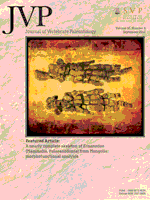In this paper are described the arvicolines from El Chaparral site (Villaluenga del Rosario, Cadiz, Southwestern Spain). Due to their wide geographical distributions and rapid evolutionary rates, arvicolines are especially useful for biostratigraphical purposes. The stratigraphic layers of El Chaparral have yielded arvicolines remains of the genera Allophaiomys, Iberomys, Pliomys, and Terricola. The presence of these rodents together the other vertebrates recovered allows to determinate the age of the El Chaparral site and compare our data with other Iberian Pleistocene sites, such as of the Sierra de Atapuerca. El Chaparral site ranges between the Jaramillo Subchron (1.07–0.99 Ma) and shortly after the Brunhes-Matuyama transition at 0.78 Ma covering a important time span for the knowledge of the earliest humans occupations in western Europe.
How to translate text using browser tools
1 September 2012
Biochronological Data Inferred from the Early Pleistocene Arvicolinae (Mammalia, Rodentia) of the El Chaparral Site (Sierra Del Chaparral, Cádiz, Southwestern Spain)
juan manuel López-García,
Gloria Cuenca-Bescós,
Hugues-Alexandre Blain,
Isabel Cáceres,
Núrcia García,
Jan Van Der Made,
José Maria Gutierrez,
Antonio Santiago,
Francisco Giles Pacheco
ACCESS THE FULL ARTICLE





